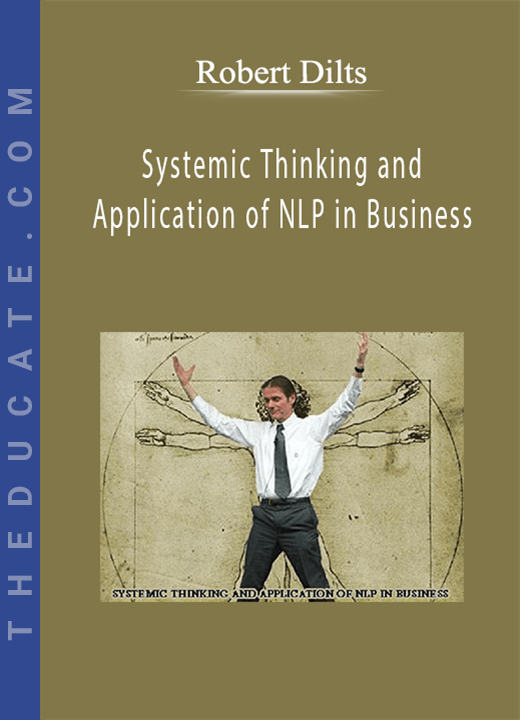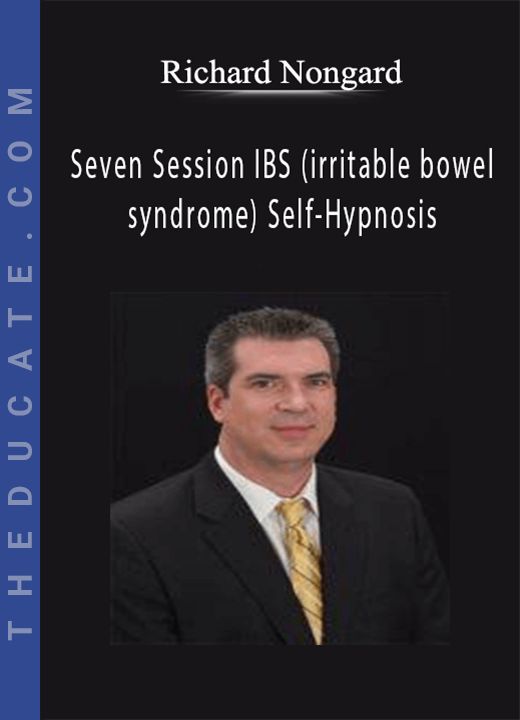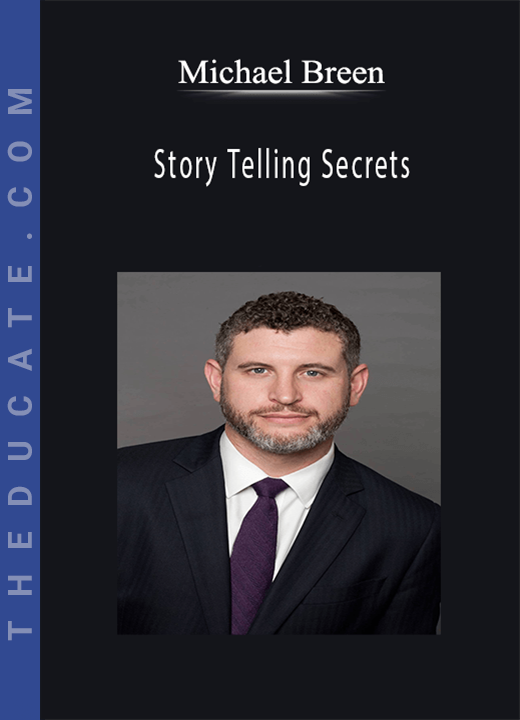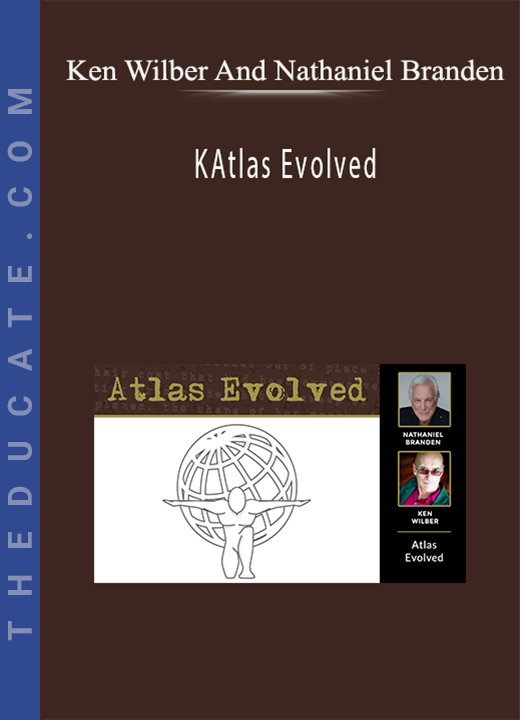Description


Robert Dilts – Systemic Thinking and Application of NLP in Business
Yet another release of unique, rare, quality and remarkable material from the biggest names in NLP.
This seminar that Robert Dilts gave in Moscow is very good, although it is a bit stop-start as a translator is used at the end of every phrase when Robert speaks.
The Systemic Nature of the Mind and Body and How it Relates to Health
An Article on Systemic Thinking and Healing by Tim Hallbom and Kris Hallbom
The whole notion of cause and effect has made healing for people in Western society more difficult than it needs to be. It would be much easier for people to heal if everyone in the world took a systemic approach towards health and wellbeing. The whole nature of systemic thinking is about the laws that govern systems, the relationships between the systems, outside of systems, and the boundaries that separate the systems. Many of today’s physicians operate, with good intention, under the constraints of linear thought when they are trying to help a patient get better. They would be much better off is they thought systemically.
Systemic Thinking versus Linear Thought
Instead of focusing solely on the “cause and effects” of the client’s disease or health condition, physician’s taking a systemic perspective might focus more closely on the systemic factors revolving around the client’s condition such as their living and working environments; their relationships with the people around them; and their relationship with their self physically, mentally, emotionally, socially and spiritually.
The first and most important step on the path of healing, when taking a systemic approach is to have the client or patient clearly imagine how he would like to be in his or her desired state of health and well being. Setting an outcome will facilitate the change process because of the brain’s ability to function as a cybernetic mechanism. This means that once the client or patient is clear on his outcome, the brain’s natural response will be to organize itself towards whatever images or beliefs he has created in his mind about getting better. The client will begin to automatically get self-corrective feedback and the brain will systematically trigger the necessary immunological responses to guide him towards the goal of health and wellbeing. (1)
According to NLP developer Robert Dilts, systemic models are different from statistical or linear models in that they deal with the feedback of total systems, systems in which events at any position in the system may be expected to have effect at all positions on the system at later times. A particular cause or effect cannot be isolated from its context. Therefore, each part must be considered and measured in terms of the whole. Human behavior, health conditions and experiences in general are undoubtedly the result of such a system. Therefore, any satisfactory model of human experience, behavioral, physiological or epistemological, must be systemic. (2)
Greek philosophers first turned their attention to linear thought in the 5th Century B.C. Since then, it has been almost universally accepted that everything that has a beginning must be caused by something else. The Scottish philosopher David Hume disagreed with the early Greeks. Hume held the idea that the causal relationship between two events occurring in sequence is nothing more than a habit of mind. In 1739, he wrote A Treatise of Human Nature, which is an analytical rejection of the commonly established ideas of causation. Hume rejected the idea that everything that has a beginning must be caused by something else.
“All we can justly say of causality is that what we take to be a cause always precedes what we take to be its effect and that there is always contiguity between the two. Beyond this nothing an be claimed,” said Hume. (3)
Established ideas of causality among evolutionary biologists support Hume’s analytical rejection. For example, how can we describe the evolution of the reptilian egg in terms of cause and effect? According to evolutionary theory, the reptilian egg is the result of the random mutations. Numerous events must have occurred for the development of the reptilian egg to succeed. Between the mutations that produced the eggshell and those that produced the embryos heart, there could be no causal connection; all of these events occurred randomly. And if there were no such connections, then how was the whole process orchestrated? From this point of view, the reptilian egg appears as the result of a culmination of improbably and random coincidences. Hence, the most logical answer to the primordial egg dilemma is to view it through the lenses of systemic thinking and systems theory.
The point of all of this is to note the difference between systemic thinking versus linear though; which is geared more towards the concept of cause and effect. Keep in mind that we are a system of interactions and we are also a system within a system within a system. The interactions that happen within a human being, between human beings and their environment are systemic and respond to certain systemic principles. Our bodies, our interpersonal relationships and our societies form a kind of ecology of systems and subsystems, all of which are mutually influencing each other. (4)
The interactionary process between all of these systems plays a key role in our personal health and wellbeing. In the following sections, the interactionary process between mind and body will be further explored.
How Do Mind Maps Effect the Body?
One of the basic presuppositions of NLP is that the map is not the territory. Everyone on this planet has their own personal filters of reality and thus, their own map of reality. The filters that we wear through life influence our personal map of reality. Everyday we trek through similar territories, but because we wear different filters and use different maps, those territories appear different.
As human beings, we can never know reality because we have to experience reality through our five senses, and our senses are limited. Therefore, we don’t tend to respond to reality itself, but rather to our own maps of reality. We all have our own worldview and that view is based upon the sort of neurolinguistic maps that we have formed. It’s these neurolinguistic maps that will determine how we interpret and how we react to the world around us and give meaning to our behaviors and our experiences, more so than reality itself. Thus, its’ generally not external reality that limits us or constrains us or empower us, but it’s rather our maps of that reality. (5)
One of the primary constituents of our personal maps of reality is that of imprints. An imprint is basically a memory that is formed at an early age, and can serve as a root for both the limiting and empowering beliefs that we may form as children. Some of the limiting beliefs that we may develop at these early ages are not always healthy, and are created as a result of a traumatic or confusing experience that we forgot. How we unconsciously and consciously view the world in terms of health is generally based on those beliefs.
Having an imprint laced with unhealthy beliefs can create serious problems for the immune system. Keep in mind that the brain is systemic, meaning that if you’re creating unhealthy beliefs in your life based on unconscious imprints, the brain will attempt to self correct those images or beliefs in the form of an immunological response. Even if the limiting beliefs are repressed or forgotten, the brain is still capable of serving as a catalyst for undesirable health conditions because of its systemic capabilities.
Many unhealthy immunological responses are the result of limiting beliefs that were created through confusion or traumatic experiences. These types of limiting beliefs contain two aspects and those aspects exist within the imprint or memory. One aspect is the way you perceived the trauma/confusion as a child, the memory or feelings of the younger you still exist inside the imprint.
The other aspect that we incorporate when we experience a trauma as a child is the point of view of the other people who were there at the time of the event. Some of those people might include family members, teachers or friends. It is during the formation of these early imprints that the limiting beliefs are formed. These limiting beliefs are capable of systemically manifesting in the form of a disease or ailment in later years. (6)
How Do Beliefs Effect the Territory?
The notion of beliefs and health is a concept that goes hand in hand with maps and territory. If the mind is the map and the body is the territory, then the unconscious and conscious beliefs that we have about our personal health are going to effect us systemically; as well as throughout the neurological levels of change (i.e. environment, behavior, capabilities, beliefs and values, identity and even spiritually to a certain extent). (7)
Unresourceful physical manifestations and psychosomatic problems, which are generally based on beliefs, are made apparent through the interactions of the brain’s cerebral cortex, limbic system and hypothalamus in correlation with the autonomic, endocrine, immune and neuropeptide systems. And in the same breath, the ability to heal ourselves from such conditions by creating healthy beliefs in exchange for the old ones– is also made apparent through the same cerebral interactions. (8)
At the center of all of this amazing activity is the hypothalamus, which receives signals from all parts of the nervous system so that it functions as a central information exchange concerned with the well-being of the entire body.
The hypothalamus lies in the very middle of the limbic lobe. Although is a relatively small structure (comparable to the size of a pea and weighing no more than a few grams) it is an important structure. It controls the autonomic nervous system which is made up of the parasympathetic and sympathetic systems, creating physical excitatory and inhibitory responses within the body; and it controls the endocrine system and organizes behaviors that are related to the body’s basic regulatory and survival systems (hunger, thirst, fighting, fleeing and sex). The hypothalamus thus, integrates the sensory-perceptual, emotional, and cognitive functions of mind with the biology of the body. (9)
The most recently recognized regulatory function of the hypothalamus is its influence on the immune system. According to Earnest Rossi, author of The Psychobiology of Mind Body Healing, there are actual psychophysiological mechanisms whereby the hypothalamus can alter both cellular and hormonal immune activity within the limbic system. (10)
Moreover, because the immune system is within the limbic lobe and the limbic lobe is basically the center for our emotional and cognitive functions; and certain emotions and beliefs are attached to various imprints within the unconscious mind, then it is possible to see and understand how we can become susceptible to unresourceful health conditions and diseases.
Rossi further states that the autonomic nervous system has been regarded traditionally as the major means by which therapeutic hypnosis is capable of achieving it’s biological effects.(11) If this is true, then it seems apparent that the autonomic nervous system would serve NLP interventions in the same way.
Based on all of the aforementioned information, it is only logical that if you change a person’s beliefs, then it is possible to change their physical state of being from an unresourceful state to that of health and well-being- given that the new state is ecological throughout the systemic and neurological levels of change.
Using NLP to Create Systemic Change Within the Mind and Body
Neuro-Linguistic Programming can help a person through many of the roadblocks that keep them from healing themselves. One of the more common roadblocks for many people to overcome is their inability to believe in their own healing process. If someone believes that they aren’t going to get better, then they won’t take the necessary steps to get better.
In Robert Dilts’ book, Changing Belief Systems with NLP, he states that most people who have a difficult time recovering from an illness or condition usually adopt one of the following beliefs about their recovery process.
Hopelessness: If a person is hopeless he feels or believes an outcome is just not possible. A typical statement would be, “There is no hope.”
Helplessness: If a person is helpless he feels or believes that he does not have the capability of getting better. Some typical statements would be, “I am not good enough”; “I don’t have the capability to heal myself”; or “Healing is possible, but I’m not capable”.
Worthlessness: If a person feels or believes he is worthless, then he thinks that he doesn’t deserve to heal. A typical statement would be, “Maybe I don’t deserve to be healthy.”
When working with any limiting belief such as the ones mentioned above, the NLP Practitioner’s primary goal is to move the client from his present state of discomfort to the desired state of health and well being. This can be done, by helping the client create appropriate beliefs for the way he’s chosen to heal from his condition. There are many NLP processes that can be used with the client to help him achieve his outcome. (12)?
Case Example
NLP trainers and co-authors Tim Hallbom and Suzi Smith used NLP methods to help a woman who had a cancerous thyroid. The woman had two biopsies and tested positive for cancer both times. Hallbom and Smith spent 4 hours working with her in two different sessions. When the woman went back to her doctor, he told her that the cancer on her thyroid seemed smaller than it did before, but that he wanted to go ahead and operate on her anyway because waiting could be dangerous. When he operated he found that it had, in fact, shrunk up and it was no longer malignant. (13)
During that 4-hour session, the NLP trainers did some reimprinting (14) with the client and they helped her to integrate some deep-rooted unconscious conflicts that she had within herself. They did this by assisting her to identify the positive goals and intentions behind her conflict.
One of the NLP presuppositions is that there is a positive intention behind every conflict, limiting belief or problem. This means that some aspect of the person is benefiting in a positive way from their limiting behavior, otherwise they would not be demonstrating the behavior.
A classic example of this presupposition would be of the teenager who starts smoking to gain attention. Even though smoking isn’t positive or healthy, the unconscious mind might deem the attention that is gained from smoking– as positive attention.
It was observed that the woman’s goals were in conflict. When there is a goal that is in conflict with another goal, you begin to fight yourself. One way of fighting yourself is by developing a disease such as cancer, according to Hallbom.
While working with the woman, Hallbom assisted her in re-identifying and integrating her goals. Once her goals were integrated, they were then able to assist her in moving towards her desired outcome of health and well-being. Until you know what the positive aspect of the limiting beliefs or conflicts are, you can’t do that and that’s why NLP and systemic thinking are such valuable tools for helping people with health issues. (15)
References
- Dilts, R., T. Hallbom and S. Smith, Beliefs: Pathways to Health and Well-Being, Portland, OR: Metamorphous Press, 1990.
2. Dilts, Robert, Roots of Neuro Linguistic Programming, Cupertino, CA: Meta Publications, 1983.
3. Hume, David, A Treatise of Human Nature, London, England: Longmans Green, 1874.
4. Based on an essay that Robert Dilts wrote on NLP Presuppositions and Creativity.
5. Ibid.
6. Hallbom, T. and K. Johnson Hallbom , Future Medicine Now, Beverly Hills, CA: The Holistic Book Project, 1993.
7. Robert Dilts is the primary developer of the Neurological Levels of Change.
8. Carlson, Neil, Physiology of Behavior, Newton, Mass: Allyn and Canon, Inc., 1986.
9. Rossi, Earnest, The Psychobiology of MindBody Healing, Makham, Ontario: Penguin Books Eanada, 1986.
10. Ibid.
11. Ibid.
12. Dilts, Robert, Changing Belief Systems with NLP, Cupertino, CA: Meta Publications, 1990.
13. Dilts, Hallbom, and Smith, Beliefs: Pathways to Health and Well Being.
14. Reimprinting is an NLP process that was developed by Robert Dilts.
15. Hallbom, T. and K. Johnson Hallbom, Future Medicine Now.






4 reviews for Robert Dilts – Systemic Thinking and Application of NLP in Business
There are no reviews yet.